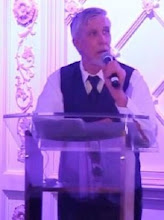Penny's Blog: Introduction
[To skip the introduction and go straight to the pennypoem, click this link.]
Penny's Poetry Blog went public on New Year's Day 2010, with the publication of our first (and still the longest) pennypoem, "Penny (or Penny's Hat)". To mark the blog's 15th anniversary, we are publishing a new pennypoem, "Penny's Blog".
So what is a pennypoem? First and foremost, it is a "conceptual" poem. Conceptual poetry, as the Academy of American Poets explains it, is:
an early twenty-first century literary movement, self-described by its practitioners as an act of "uncreative writing." In conceptual poetry, appropriation is often used as a means to create new work, focused more on the initial concept rather than the final product of the poem.(Academy of American Poets, "A Brief Guide to Conceptual Poetry")
The basic idea, as I understand it, is similar to a "found poem," which takes non-poetic text and repurposes it as a poem. In addition, though, conceptual poems are governed by an overriding concept that acts as a rule of writing; essentially, it deals with the lack of formal rules in free verse by substituting a different rule or set of rules.
Source texts can be anything. In "Penny" the sources were various lists of colors; in "Penny's OS" they were software operating systems; in "Penny's Cat is Dead" they were euphemisms for dying; and in "Penny's Blog" they are the titles of all the poems that have appeared on the blog over the past fifteen years. In all cases the conceptual rule has been to compile all the source texts into one comprehensive alphabetical list.
Which brings us to the second feature of pennypoems; they are "list poems". List poems have a long, if not respectable, history. I first encountered the term in a work by Northrop Frye, who argued that the "list of reminders or stimuli" is "the central technical device of nostalgic verse," citing this example by Canadian poet Edna Jaques:
The strong clean smell of yellow soap,
A farmer plowing with a team,
The taste of huckleberry pie,
A pan of milk with wrinkled cream.
All words have power to stimulate independent thoughts in a reader; in "Penny's Blog" that is especially so whenever the reader recognizes a poem title. The main point of the pennypoems, though, is to evoke sonics rather than images; to write poetry that is organized around sound rather than sense. Which makes the third poetic type in which pennypoems can be classified: "sound poetry." The items on the lists are chosen and grouped together, in various combinations depending on the poem, to make the best sounding lines. (For that reason, I would suggest reading the poems both quietly and aloud at different times.)
An optional feature of some pennypoems has been the production of 2.0 versions: hyperlinked versions of the poem that one can use for further information on the words used. In Penny's Blog 2.0" the links lead directly to the poems on the blog; so long as the blog remains active, so do the links. "Penny's Blog 2.0" appears down below following "Penny's Blog".
One final feature of pennypoems can be noted: all of them begin and end with a short frame tale featuring Penny, a fictional character whom I invented to be the virtual editor of the blog. These brief narratives are a nod to conventional narrative poetry, meant to be somewhat tongue-in-cheek.
Despite the frame tales, I must stress that a pennypoem is the furthest thing from narrative poetry. There is no storyline, no narrative progression no development, and therefore no reason to start at the beginning and read through to the end. That is why the pennypoems are presented on the blog as individual stanzas, rather than as a continuous work. One can read "Penny's Blog" as a continuous work, of course, if one wishes; to do so, simply click the "begin reading" link underneath this essay to get to the first stanza, then click the "continued" link at the end of each stanza to go on to the next. However, it makes just as much sense to browse through the poem at random; to read it that way, use the table of contents on the left side of the page.
And that is probably more information than a reader needs or wants to know. (If you do have questions, or other comments, feel free to post them in the comments section at the end of this piece.) So, please go have a look at "Penny's Blog." I hope you will have some of the fun reading it that I had writing it.
[Begin reading:]


















No comments:
Post a Comment